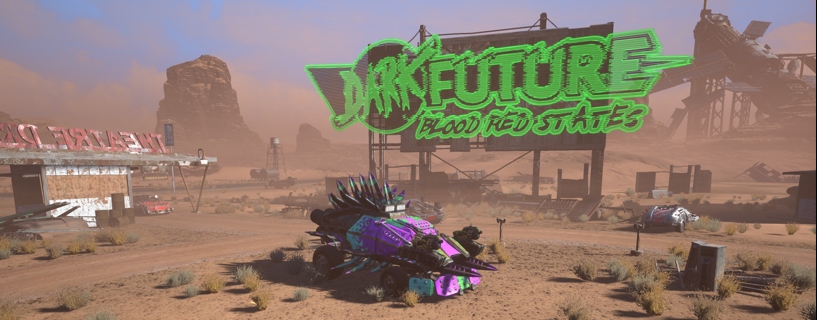While a very different game to its board-game ancestor, Dark Future is a great evolution of the source material. Just ask President Emilio Estevez!
Genre: Strategy
Developer: Auroch Digital
Publisher: Auroch Digital
Release Date: 17 May, 2019


Introduction
Dark Future: Blood Red States is the latest game from Auroch Digital, based on Games Workshop’s last-century table-top board game, Dark Future. This isn’t Auroch’s first foray into Games Workshop or board-game conversion territory, having previously brought us Chainsaw Warrior and Ogre.
Dark Future is set in an alternate history, near-apocalyptic future USA. Rock and roll is dead, corporations rule the USA, and the world’s climate has been savaged by pollution, leaving much of America devoid of water and life: The Big Empty. Life is cheap and dangerous and the highways are roamed by bandit gangs, terrorising both flesh-and-blood and robotic travellers alike. Law Enforcement has been expanded to include Sanctioned Operators, talented and well-equipped civilians keen to strike out against the violent gangs, and earn a hefty pay cheque in doing so: state-sponsored vigilantes, if you like. You play the role of one such Operator in the Big Empty around Salt Lake City, taking on a series of short missions in your weaponised vehicle for your corporate or government employees.
While some lovers of the old Dark Future table-top board game have taken to the Steam discussion forums to air their gripes about the game not being true to its roots, the developers have stated repeatedly that Blood Red States is set in the Dark Future world and is influenced by the original game, but their goal was never supposed to be to make a direct copy of it. Not having ever played the original — though I think I may have been given it at one time in a big box full of table-top RPGs, wargames, and board games — I can’t comment on the similarities or differences, but having a small amount of familiarity with the game world, I do think the developers have done a pretty good job maintaining its wacky atmosphere.
For such an ugly world, it looks very pretty!
First impressions are good, with a brief historical CG movie providing a very rough outline of the Dark Future world and a great looking animated title screen. Title music is fairly heavy and unafraid of distortion and the game’s menu interface is unashamedly retro in look and feel.
Graphics in game are impressive. Special effects and atmospheric effects look really good, with great explosions, fire, and debris-laden wind being particularly cool. Vehicles, too, are mostly modelled and animated exceptionally well, including moving weaponry and some great high-flying tumbles that leave smoking wrecks behind you (or in your path — whoops!). Damage effects seem to be fairly limited, though, with no capacity for blowing off parts or weapons, but even so it does look very nice.
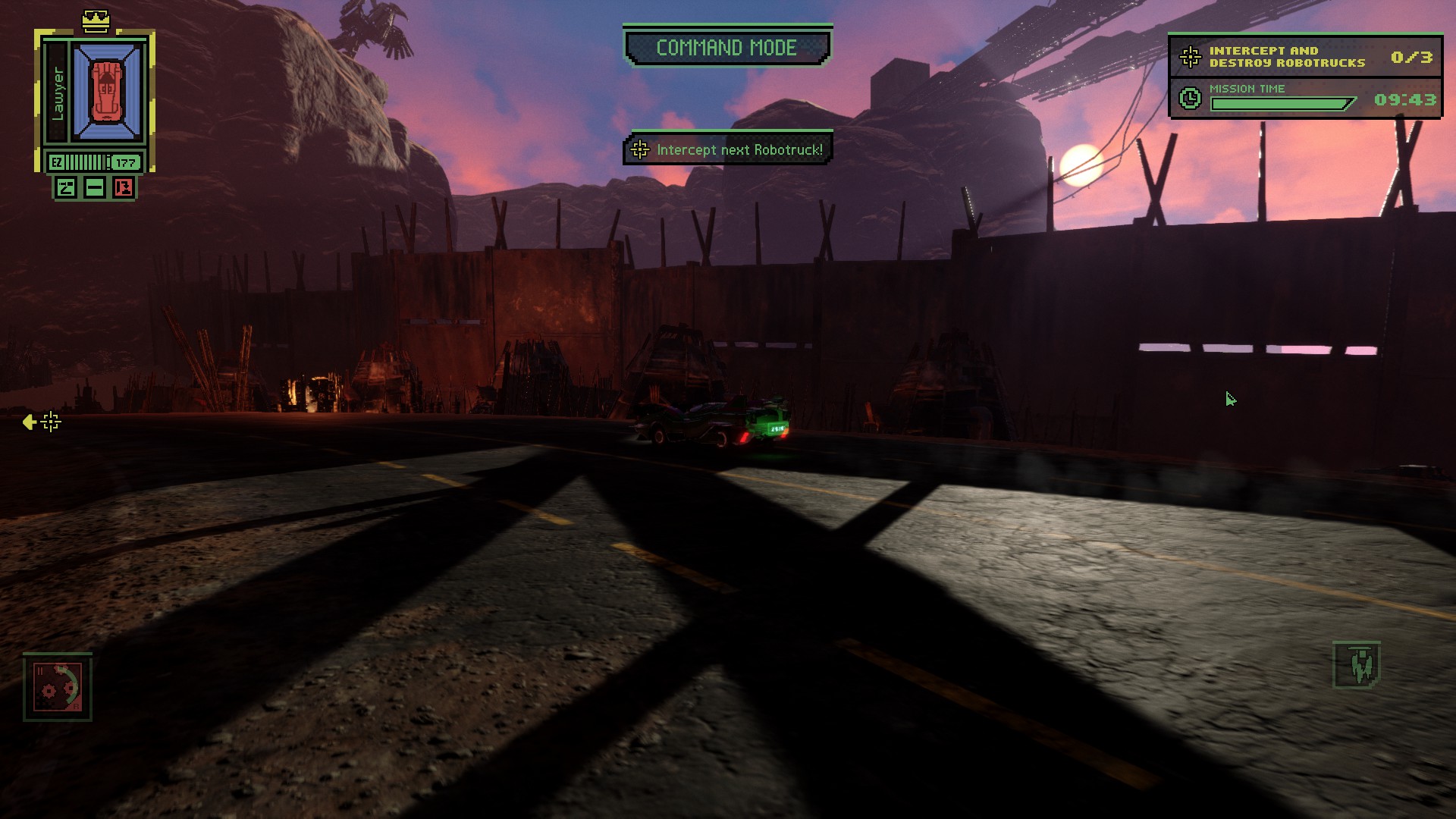
The world graphics are a slightly mixed bag, though. The gameplay is such that you’re restricted to driving on the designated highway, which passes on its procedurally generated path through what I assume is procedurally generated terrain, sporting mostly fairly sparse and relatively limited variety of obstructions, vehicles, and scenery objects. While what’s here actually does look very good, there’s just not enough variation to avoid the impression that you’re seeing the same stretches of road over and over again. With only a handful of different scenery areas, too, once you’ve played a couple in each everything starts to look pretty samey.
Music is good, but mostly fades into the background. I couldn’t even tell you how many music tracks there are, but mostly they have a sort of Terminator type feel to them: dark and foreboding with a heavy beat. Sound effects are great except for the sound of metal-on-metal during ramming or crashing; this sounds exactly like someone playing a cymbal.
I found the interface to be a little confusing initially, but got to grips with it fairly quickly thanks to the short, but detailed, tutorial, and some excellent tooltips. The writing is fantastic, with lots of dark humour and pop-culture references, in the traditional Dark Future mould. I’ve only noticed a few very minor errors that seem most likely to be “typos”. Given the large amount of writing in the game, that’s very good indeed.
Performance is mostly excellent with everything on Ultra settings on my GTX1070-based laptop, but I do sometimes experience short freezes of about a second or so duration, usually when first starting a mission. Given the very short load times, my guess is that it’s streaming in part of the world or something.
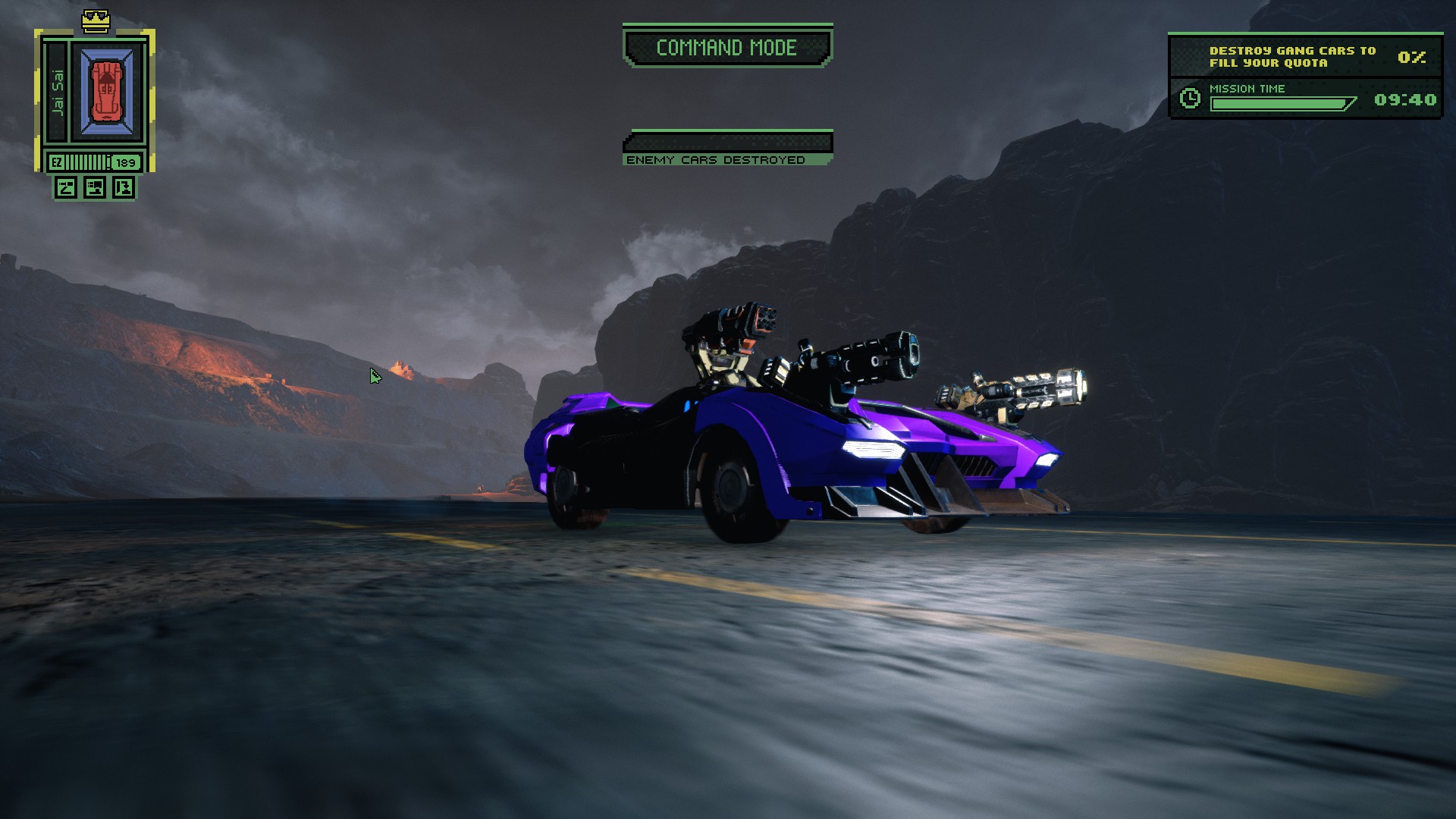
Seasons and vehicles
Each game of Dark Future: Blood Red States is described as both a “season” and a “run”, the latter terminology being typical of Rogue-like games. You choose a character — each of which has a single special ability, such as increased damage of a certain type — a vehicle, and a perk, and start the game. You’re given a series of static objectives, which are the same for each run of the same character, but all missions except for the last boss mission of each run are procedurally generated. The game also features other elements common to modern Rogue-like games, such as permadeath and meta progression, in the form of features unlocked or improved on future runs.
The game is played in two separate modes: the lobby-type area, where you read emails, kit out your vehicle, hire Operatives, and take on missions; and the missions themselves, where the core gameplay takes place.
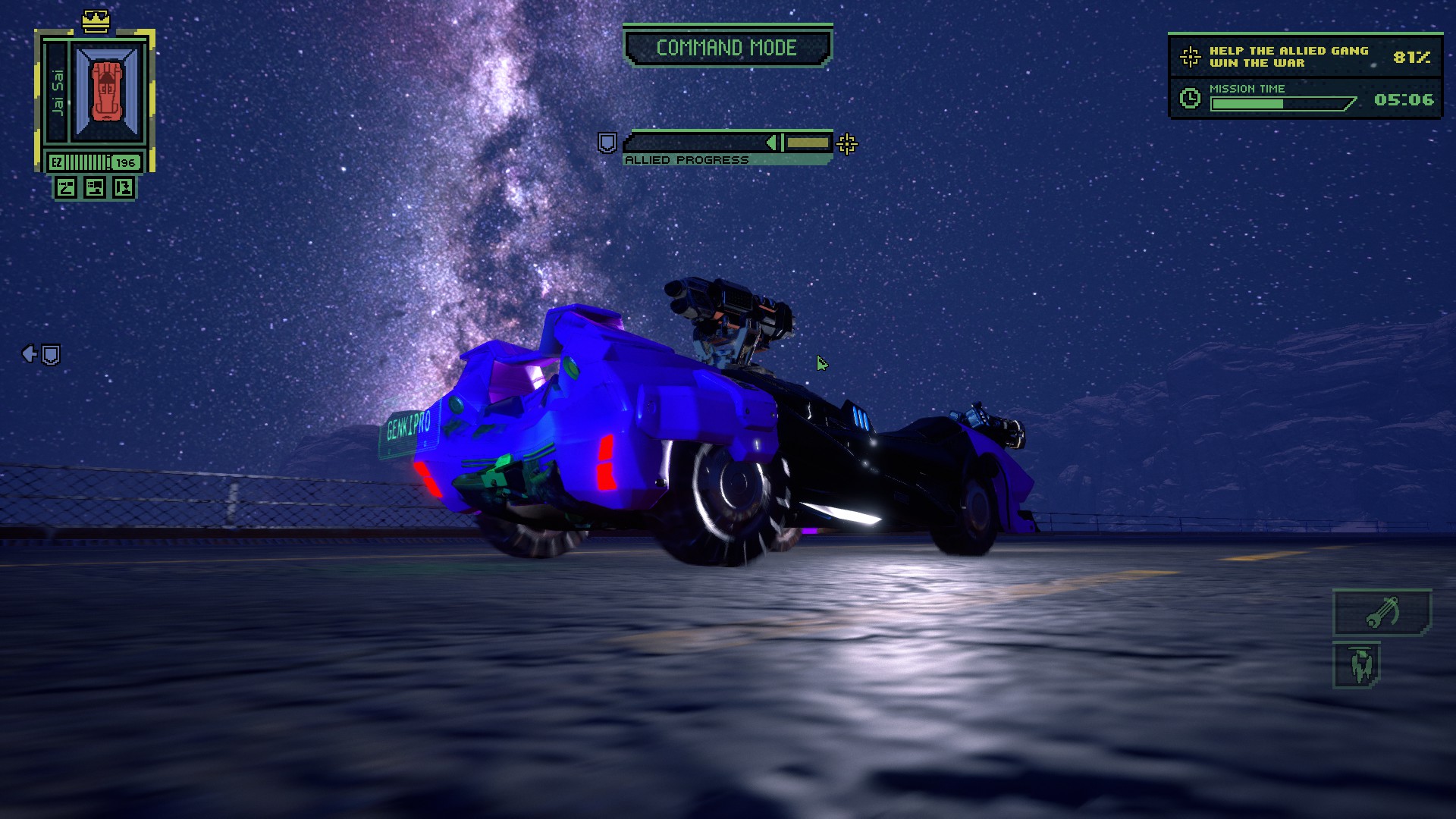
Typically you’ll only spend a couple of minutes between missions in the lobby area. Each visit you’ll get a new “flavour” email and, if you’ve completed a special objective, another story-related email advancing the plot and describing the next objective. Completing all objectives for a run unlocks some more features for the next run and takes you back to the main menu, effectively winning the game. From here you can also kit out your vehicle in the shop and choose one of a handful of randomly assigned missions to play next. Corporate reputation increases as you play missions for each corporation, eventually unlocking special items for future runs.
The shop allows you to purchase vehicle modifications, which are fun, but there’s not a huge range. Your vehicle will have two or three weapon hardpoints and four or six customisation slots. Each visit to the shop randomises the available items, but you can sell back items at the same price you paid for them, so the only risk involved in trying something out is that you’ll have to sell whatever was in the slot previously, leaving you at the whim of the shop RNG next visit.
Vehicles have maximum weight — improved up to a point through engine upgrades — as well as front, rear, and side armour slots. Other characteristics, such as number of slots and speed, are fixed for each vehicle. You can customise your vehicle in a rudimentary manner, setting license plate characters and primary and secondary paint colours. You also need to make sure you have enough fuel, which changes price (generally increasing) with each new mission in a run. Run out of fuel or die in a mission, and it’s normally game over.
Missions and more missions
Missions come in a small number of flavours, such as escort, gang attack, and hacking. With only a couple of exceptions, for the most part they all play basically the same: destroy enemy vehicles until a counter reaches a threshold in time or number of kills. There is some variation, such as escort vehicles requiring you to protect another vehicle (while also giving you direct control over it in Command Mode, which is cool — I wish other games’ escort missions would do this!) or gang attacks spawning a boss vehicle for you to destroy in order to end the mission, but they all play out pretty similarly, really.
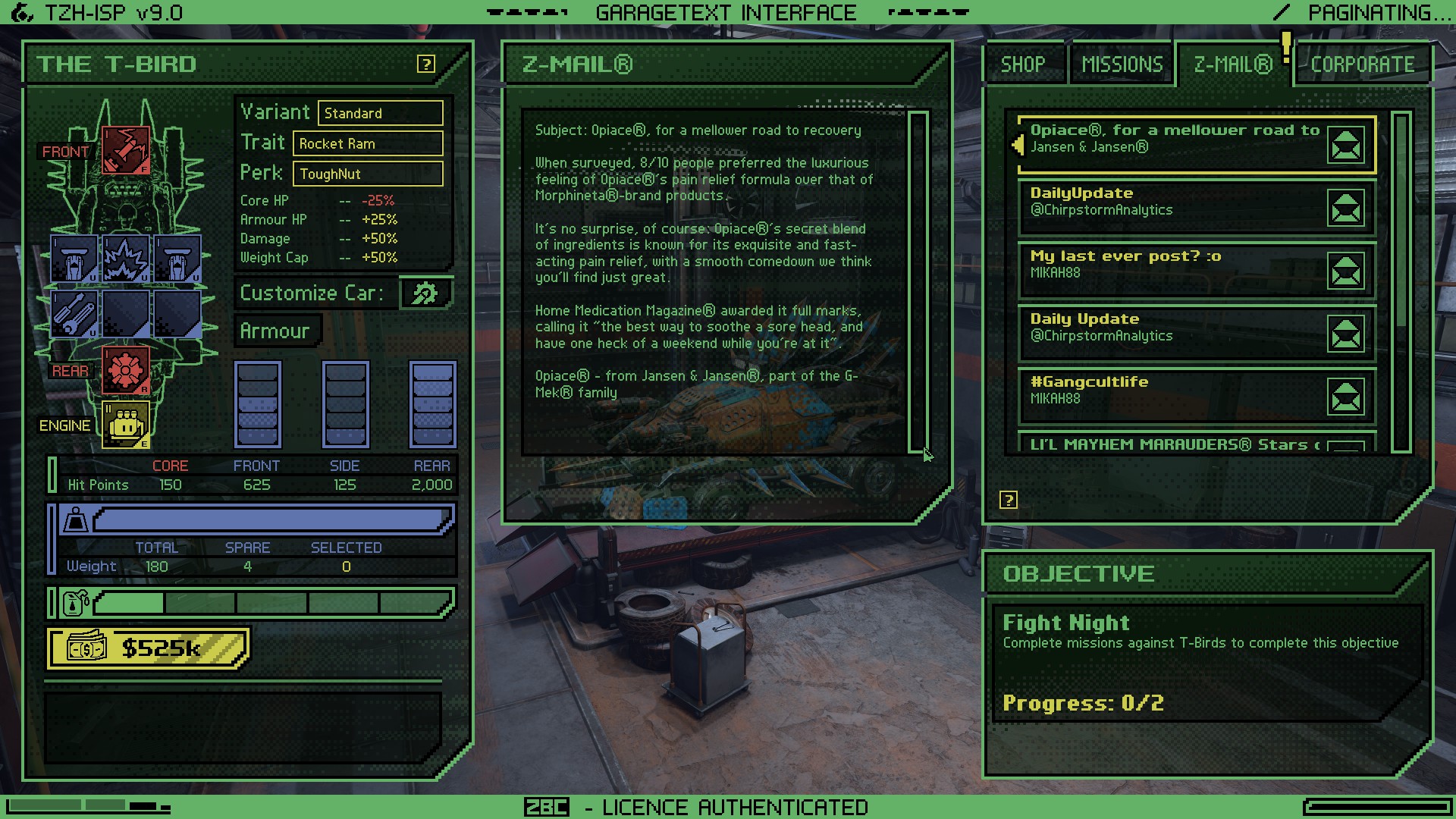
Data Theft and Blockade Run missions are slightly different, with hacking missions involving positioning your vehicle in a little moving bubble alongside typically well-armoured and outfitted “robotrucks” while your hacking meter fills up, usually while trying not to be turned into paste by the attending enemy vehicles; and Blockade Run missions being the easiest by far, simply involving you making your way through a sparse series of road obstructions, usually speeding as fast as you can and dodging any enemy vehicles that get in your way or pursue.
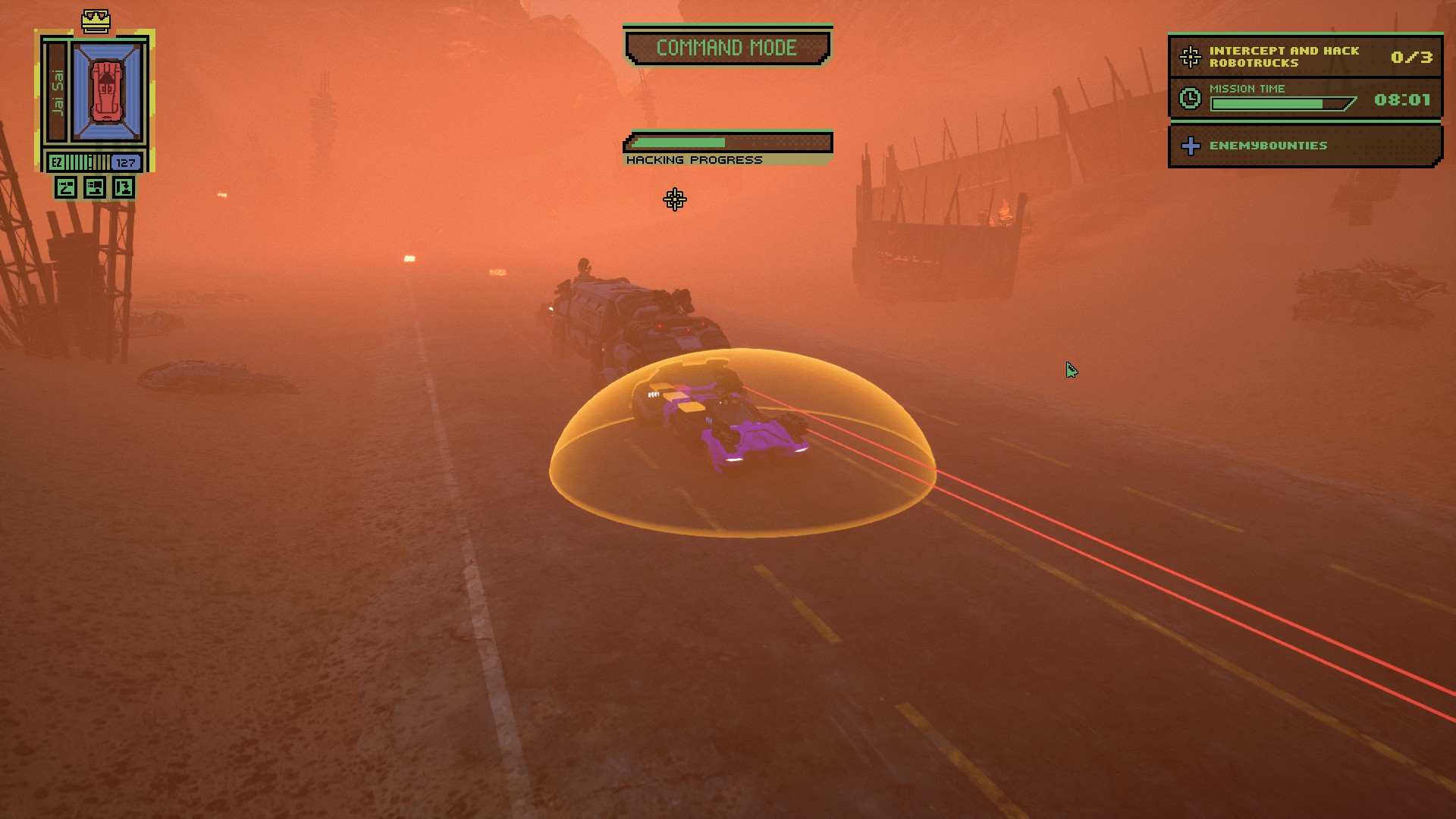
Each mission has a difficulty represented from one to three skulls, but I suspect there must be some leeway in the procedural generation, as I’ve had single-skull missions take me far closer to death on occasion than three-skull missions. As you progress further you’ll see “mutators” start to appear to. These are modifiers to the base missions that have certain effects, such as all vehicles having weak points on their right-side armour, or all enemies being more powerful than usual. They’re a nice addition to the game and do manage to spice things up a bit, but ultimately they’re not enough to make the missions feel significantly different to their non-mutated counterparts.
EZ DRIVE
Regardless of the mission type, you don’t directly control your vehicle! Instead, it’s fitted with an EZ DRIVE ™ AI system, which controls all of the intricacies of actually keeping the vehicle moving along the highway — which is the only area in which you’re allowed to drive — and firing the fitted weapon systems. You interact with the EZ DRIVE by setting target speeds in forward or reverse, braking, boosting, nominating a target for speed matching or turret weapons, or firing weapons. Most actions are on cool down timers, requiring at least a small degree of strategy in your decision making.
Missions are in real time with the interface to the EZ DRIVE being accessed through hotkeys or “Command Mode”: a tactical pause, the likes of which has seemed to grow in popularity in RPGs over the last couple of decades. Except it’s not actually a pause, but rather a super slow motion mode, which can be dynamically sped up in bursts if desired. After playing for less than an hour I was already wondering why the developers would have chosen slow motion rather than an outright pause; while I admit it does look sort-of cool, it doesn’t really offer any tactical advantage over pause and I think it must have been significantly more work to implement. Early on in particular I found myself entering Command Mode so often during combat that it completely disrupted any real-time flow in the game, reducing encounters to series of rapid-fire stop-start clickfests. The hotkeys do work well to alleviate this, but I found them a little awkward to get used to for some reason, and I was left wishing that the game would either enter a true turn-based mode once an enemy is in range or do away with the Command Mode entirely and just rebalance everything so it’s more accessible and usable in real time.
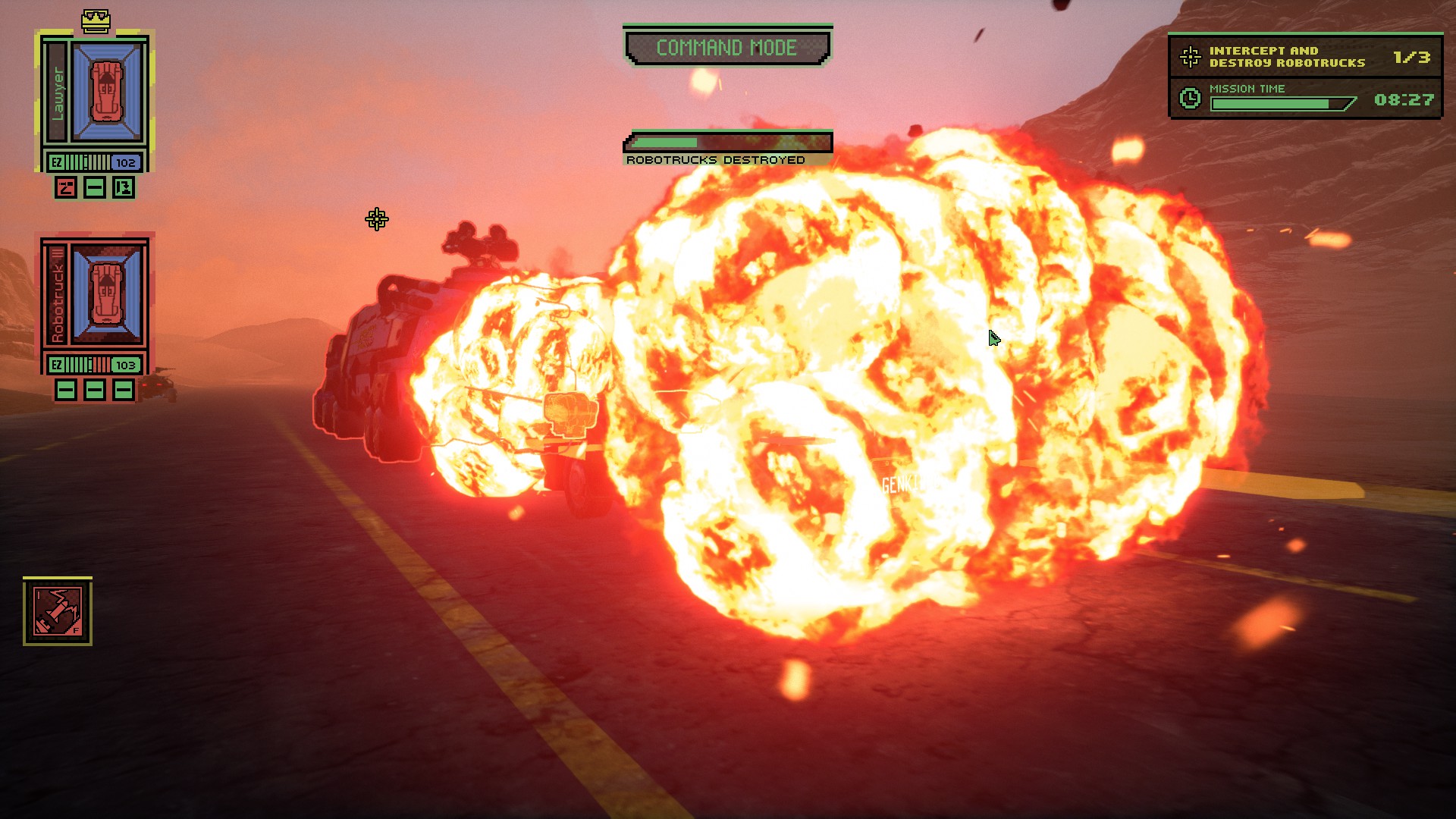
You can hire a second Operative for missions, too, giving you direct control over two vehicles. While this is a great idea and looks good on paper, once I became used to hotkeys for my primary vehicle I just found it too distracting to keep entering Command Mode to swap vehicles and issue orders. Usually I just let my second Operator take the lead to draw enemy fire, but unfortunately there’s no way to let AI control the weapons, so they tend to go unused since it’s too much hassle firing them myself. This part of the game feels like a massive missed opportunity; even some rudimentary AI firing at the closest enemy would do wonders to improve the game with regard to hiring an extra Operative.
The game also has Steam Achievements and Trading Cards, which is great, but at least one of the Achievements is unrealistic: fail 1000 runs by dying. I can’t imagine even attempting 1000 runs in this game, let alone failing them!
Physics and other failings
Probably the game’s biggest failing is the lack of variety in everything. With only slightly more than a handful of mission types, five different mission areas, and only very limited car modifications, it feels a bit like you’ve seen everything there is to see within only an hour or two of playing. It’s not quite that bad, with the rogue-like elements; multiple characters, perks, abilities, and vehicles; and meta-progression through the corporate reputation system all increasing replayability somewhat, as well as that “just one more go” factor, but it would have been so much better if there were simply more of everything.
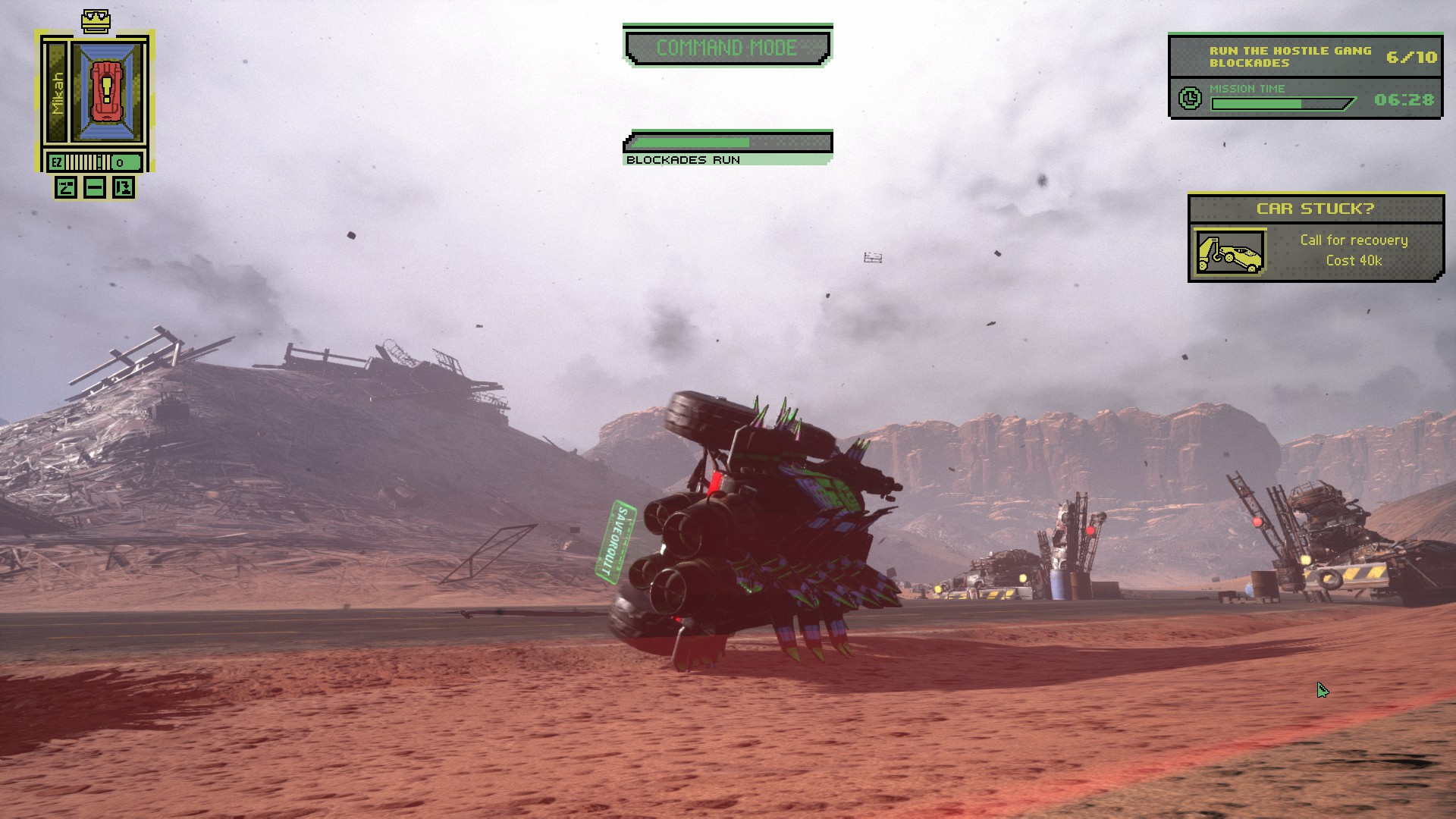
It’s also pretty buggy. I haven’t had any real game-breakers yet, but in my first six hours’ play I had two UE4 crashes (one on exit), multiple instances of UI elements not working (frozen camera, key presses not registering, sound inexplicably vanishing), a level starting off all black until I entered Command Mode and exited again, getting stuck in reverse, and the EZ Drive unit driving me into a wall and leaving me there with no controls available. They’re all fairly minor — probably the ignored key press issue is the most annoying — but I do seem to run into them regularly, detracting from the enjoyment of the game.
I’ve decided that the ridiculously over-enthusiastic physics engine is probably not a bug — it’s pretty darn fun watching chunks of wrecked gang vehicle cartwheeling tens of metres into the air, after all! — but it can be frustrating when it continually catapults your car into the air from minor collisions, invariably dumping you upside down and forcing a recovery fee on you. Enemy AI tends to cope somewhat poorly with recovering from some situations arising from the physics engine, too.
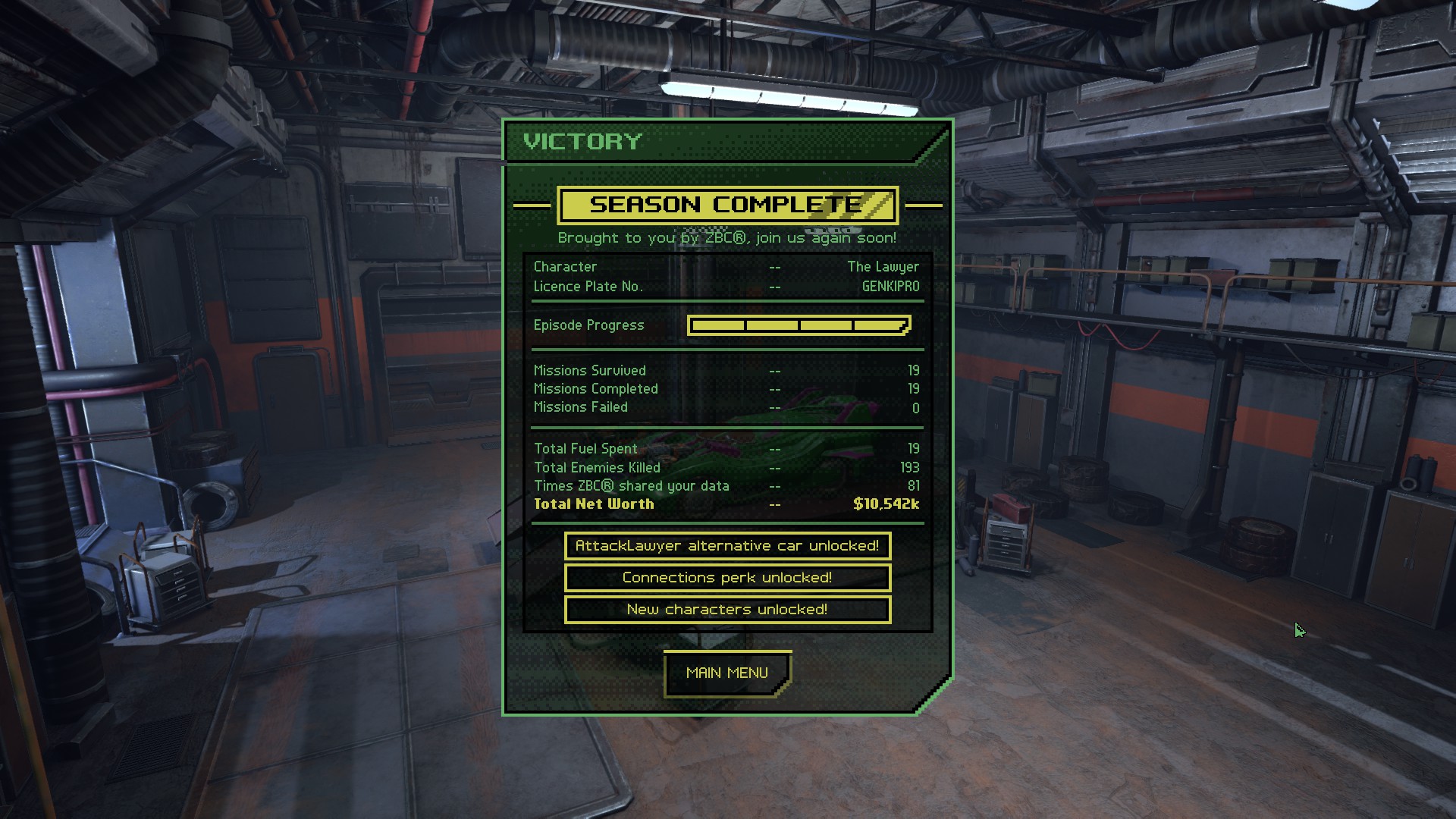
Verdict
While it’s fair to say that I’m a tiny bit disappointed in Dark Future: Blood Red States after waiting for it for so long, I think it should also be pointed out that my high expectations were probably unreasonable given the stated goals of the team and the final price point, which is a good deal lower than I’d expected.
Graphics and writing are excellent and really help to give the game that Dark Future feel, but I would have loved to see much more variation in the world, weapons, enemies, and, most importantly, mission types. And personally I think the game would actually flow better if it were either fully real time or fully turn based; hotkeys work well and the Command Mode as it stands works well enough with only one vehicle, but the constant swapping between modes, especially with two vehicles, interrupts the pacing and feels like it shouldn’t be necessary.
At the time of writing this review I’m about 10 hours in, with half of the eight seasons currently available completed, and I suspect I’ve probably seen the majority of what the game has to offer, though there may still be a few surprises left. Ultimately it’s very repetitive, but I can’t deny that it’s also jolly good fun! I’m hoping to find the time to finish the rest of the seasons soon.

